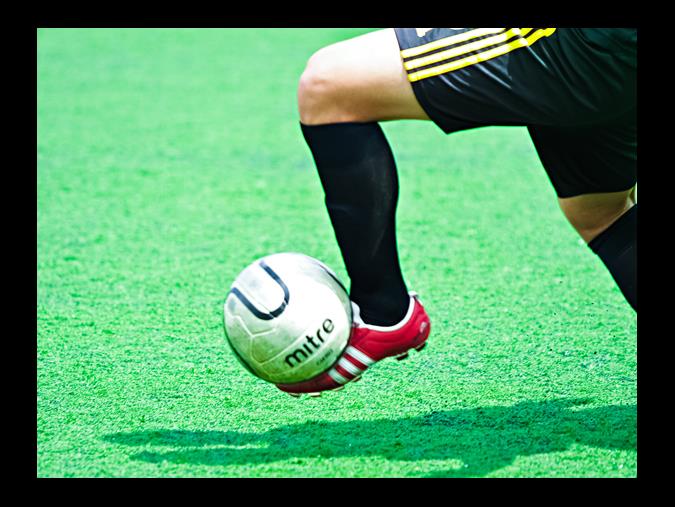How do you control a moving football?

File Photo Credit: Farhana Beunsro Jaaf
By Lim Weiyang
MASTER YOUR FOOTBALL TECHNIQUE (7): BALL CONTROL
The ability to control a moving football is essential no matter what position you play in. Just like passing, ball control forms the foundation of football. You can't keep possession of the ball if you can't control the ball when someone passes it to you, this relationship is painfully obvious.
This article will provide you with useful tips to improve your ball control technique - basically to control a moving ball when receiving it from a ground pass or when the ball is in flight. We will first explore why the first touch in receiving a ball is important.
What is the aim of your first touch?
Your first touch should cushion the impact of the ball, bringing it under your control and protecting the ball from opposing players. If you are not able to do so, every time someone passes the ball to you, it will be taken away from you easily by the opposition and possession of the ball for your team would be lost.
However, in some situations it would be advantageous to not slow down the pace of the game, and immediately pass the ball off to a teammate or attempt to shoot on your first touch. Even then, having a good touch will add to your ability to execute such moves to perfection.
Where should we play the ball to?
When you are about to receive the ball, your first touch should take it into a space beneficial for you to carry on with the ball or where you can easily pass it to another team mate. If you can receive the ball and chest it into space in front of you before your opponent can get to it, that is also considered having good ball control. If your back is to your opposition, typically you want to keep the ball near your body so cushioning the ball would be more ideal.
Next, we will share a mental check-list of 3 steps to keep in mind when receiving a moving ball.
1. Get in position
Anticipate where the ball is going to land and try to get into position beforehand. As you poise yourself to receive the ball, your body weight should be well balanced so you have the flexibility of changing direction.
3. Decide which body part makes contact
After you position yourself in the ball's landing location, you will have to evaluate the best body part to make contact with it. Would it be your chest, head, feet or thigh? Long passes from great distances usually require you to take the ball down with more cushioning to reduce the impact from the ball's flight.
4. Eyes on the ball
The next thing to consider would be the type of contact to make. With your first touch, do you want to cushion the ball and bring it under your control or immediately to play the ball forward on your first touch? You have to be spatially aware of your surroundings. Be aware of where the opposition is and how much space and time you have.
For cushioning, the correct motion is to pull your body part slightly back as the ball is about to make contact hence absorbing its impact. You can arch your spine backwards to cushion the ball onto your chest, pull your leg down to cushion the ball on your thigh, or glide your feet down with the ball to cushion it on your laces.
Timing is everything and you require great concentration and experience to master this fully. When you first begin, your touches are likely to be heavy and instead of cushioning the ball, the ball ends up bouncing forward instead. Even professional footballers run into that problem on occasion, so don't get too disheartened about it. With constant practice, you'll get better in no time and well on your way to having good ball control.
To receive the latest updates on the happenings in the Singapore sports scene, or to find out more about some of the latest programmes on offer at ActiveSG, like our Facebook page here.
Interested in football and want to hone your skills with the best? Or perhaps you are a parent wishing to expose your child to the beautiful game?
If your answer to either of the above is yes, then ActiveSG Football Academy is the place for you to be at. Led by former Singapore international Aleksandar Duric, and five head coaches with experience from the highest level of football in Singapore: Richard Bok, Robin Chitrakar, Hyrizan Jufri, Mohamad Hairil Amin, Isa Halim, and Steven Tan, ActiveSG Football Academy has a holistic football programme designed to build character and impart the right skills while encouraging trainees to pursue their sporting passion with the right attitude.
To find out more or sign up for the academy, visit this link here.





![ActiveSG Academies and Clubs Logo (Solid Colour)[8647]](https://www.activesgcircle.gov.sg/hs-fs/hubfs/ActiveSG%20Circle%202023Theme/images/ActiveSG%20Academies%20and%20Clubs%20Logo%20(Solid%20Colour)%5B8647%5D.png?width=150&height=65&name=ActiveSG%20Academies%20and%20Clubs%20Logo%20(Solid%20Colour)%5B8647%5D.png)




-01.png?width=200&height=141&name=Team%20Singapore%20Logo%20(Red)-01.png)



